Analysis of the Spatio-Temporal Rainfall Variability in Cameroon over the Period 1950 to 2019
Abstract
1. Introduction
2. Materials and Methods
2.1. Study Area
2.2. Data Sources
2.3. Data Analysis
3. Results and Discussion
3.1. Interannual Variability of Annual and Seasonal Rainfall
3.1.1. In the Northern Regions
3.1.2. In the Western Regions
3.1.3. In the Southern Regions
3.2. Spatial Evolution of Annual and Seasonal Rainfall
3.2.1. In the Northern Regions
3.2.2. In the Western Regions
3.2.3. In the Southern Regions
4. Conclusions
Funding
Institutional Review Board Statement
Informed Consent Statement
Data Availability Statement
Conflicts of Interest
References
- Arati, P.; Riddhidipa, B.; Chowdary, V.M.; Dibyendu, D.; Sreedhar, U.; Sankar, R. Trend analysis of time series rainfall data using robust statistics. J. Water Clim. Chang. 2017, 8, 691–700. [Google Scholar]
- Han, H.; Hou, J.; Jiang, R.; Gong, J.; Bai, G.; Kang, Y.; Qi, W.; Li, Y.; Li, B. Spatial and temporal variation of precipitation characteristics in the semiarid region of Xi’an, northwest China. J. Water Clim. Chang. 2021, 12, 2697–2715. [Google Scholar] [CrossRef]
- Aher, M.; Yadav, S.M. Assessment of rainfall trend and variability of semi-arid regions of Upper and Middle Godavari basin, India. J. Water Clim. Chang. 2021, 12, 3992–4006. [Google Scholar] [CrossRef]
- Ray, L.; Goel, N. Spatio-temporal change in rainfall over five different climatic regions of India. J. Water Clim. Chang. 2021, 12, 3124–3142. [Google Scholar] [CrossRef]
- International Water Management Institute East Africa. 2014. Available online: http://eastafrica.iwmi.cgiar.org/ (accessed on 10 February 2022).
- Ogwang, B.A.; Chen, H.; Tan, G.; Ongoma, V.; Ntwali, D. Diagnosis of East African climate and the circulation mechanisms associated with extreme wet and dry events: A study based on RegCM4. Arab. J. Geosci. 2015, 8, 10255–10265. [Google Scholar] [CrossRef]
- Camberlin, P. Nile basin climates. In The Nile: Origin, Environments, Limnology and Human Use, Monographiae Biologicae; Dumont, H.J., Ed.; Springer: Dordrecht, The Netherlands, 2009; Volume 89, pp. 307–333. [Google Scholar]
- Jury, M.R. Climate trends in southern Africa. S. Afr. J. Sci. 2013, 109, 980. [Google Scholar] [CrossRef]
- Diem, J.E.; Hill, T.C.; Milligan, R.A. Diverse multi-decadal changes in streamflow within a rapidly urbanizing region. J. Hydrol. 2018, 556, 61–71. [Google Scholar] [CrossRef]
- Tierney, J.E.; Smerdon, J.E.; Anchukaitis, K.J.; Seager, R. Multidecadal variability in East African hydroclimate controlled by the Indian Ocean. Nature 2013, 493, 389–392. [Google Scholar] [CrossRef]
- Bigot, S.; Moron, V.; Melice, J.L.; Servat, E.; Paturel, J.E. Fluctuations pluviométriques et analyse fréquentielle de la pluviosité en Afrique centrale. In Water Ressources Variability in Africa during the XXth Century, Abidjan, Côte d’ivoire; Servat, E., Hughes, D., Fritsch, J.M., Hulme, M., Eds.; IHAS Press: Wallingford, UK, 1998; pp. 71–78. [Google Scholar]
- Ebodé, V.B.; Dzana, J.G.; Nkiaka, E.; Nka, N.B.; Braun, J.J.; Riotte, J. Effects of climate and anthropogenic changes on current and future variability in flows in the So’o River Basin (South of Cameroon). Hydrol. Res. 2022, 53, 1203–1220. [Google Scholar] [CrossRef]
- Cisse, M.T.; Sambou, S.; Dieme, Y.; Diatta, C.; Bop, M. Analyse des écoulements dans le bassin du fleuve Sénégal de 1960 à 2008. Rev. Des Sci. L’eau J. Water Sci. 2014, 27, 167–187. [Google Scholar] [CrossRef]
- Nka, N.B.; Oudin, L.; Karambiri, H.; Paturel, J.E.; Ribstein, P. Trends in floods in West Africa: Analysis based on 11 catchments in the region. Hydrol. Earth Syst. Sci. 2015, 19, 4707–4719. [Google Scholar] [CrossRef]
- Descroix, L.; Sané, Y.; Thior, M.; Manga, S.-P.; Ba, B.D.; Mingou, J.; Mendy, V.; Coly, S.; Dièye, A.; Badiane, A.; et al. Inverse Estuaries in West Africa: Evidence of the Rainfall Recovery? Water 2020, 12, 647. [Google Scholar] [CrossRef]
- Bodian, A.; Diop, L.; Panthou, G.; Dacosta, H.; Deme, A.; Dezetter, A.; Ndiaye, P.M.; Diouf, I.; Vischel, T. Recent Trend in Hydroclimatic Conditions in the Senegal River Basin. Water 2020, 12, 436. [Google Scholar] [CrossRef]
- Liénou, G.; Mahé, G.; Paturel, J.E.; Servat, E.; Sighomnou, D.; Ekodeck, G.E.; Dezetter, A.; Dieulin, C. Evolution des régimes hydrologiques en région équatoriale camerounaise: Un impact de la variabilité climatique en zone équatoriale? Hydrol. Sci. J. 2008, 53, 789–801. [Google Scholar] [CrossRef]
- Mahé, G.; Lienou, G.; Descroix, L.; Bamba, F.; Paturel, J.E.; Laraque, A.; Meddi, M.; Habaieb, H.; Adegea, O.; Dieulin, C.; et al. The rivers of Africa: Witness of climate change and the human impact on the environment. Hydrol. Process. 2013, 27, 2105–2114. [Google Scholar] [CrossRef]
- Ebodé, V.B.; Mahé, G.; Dzana, J.G.; Amougou, J.A. Anthropization and Climate Change: Impact on the Discharges of Forest Watersheds in Central Africa. Water 2020, 12, 2718. [Google Scholar] [CrossRef]
- Ebodé, V.B.; Braun, J.J.; Nnomo, B.N.; Mahé, G.; Nkiaka, E.; Riotte, J. Impact of Rainfall Variability and Land Use Change on River Discharge in South Cameroon. Water 2022, 14, 941. [Google Scholar] [CrossRef]
- Sighomnou, D. Analyse Et Redefinition Des Regimes Climatiques Et Hydrologiques Du Cameroun: Perspectives D’evolution Des Ressources En Eau. Ph.D. Thesis, Université de Yaoundé I, Yaoundé, Cameroun, 2004. [Google Scholar]
- Amougou, J.A.; Ndam, N.J.R.; Djocgoue, P.F.; Bessoh, B.S. Variabilité climatique et régime hydrologique dans un milieu bioclimatique de transition: Cas du bassin fluvial de la Sanaga. Afr. Sci. 2015, 11, N°5. [Google Scholar]
- Onyutha, C. Identification of sub-trends from hydro-meteorological series. Stoch. Environ. Res. Risk Assess. 2016, 30, 189–205. [Google Scholar] [CrossRef]
- Letouzey, R. Notice de la Carte Phytogéographique du Cameroun au 1/500000; Institut de la Carte Internationale de la Végétation: Toulouse, France, 1985. [Google Scholar]
- Yue, S.; Pilon, P.; Cavadias, G. Power of the Man–Kendall and Spearman’s rho tests for detecting monotonic trends in hydrological series. J. Hyrdol. 2002, 259, 254–271. [Google Scholar] [CrossRef]
- Pettitt, A.N. A non-parametric approach to the change-point problem. Appl. Stat. 1979, 28, 126–135. [Google Scholar] [CrossRef]
- Ebodé, V.B. Impact of rainfall variability and land-use changes on river discharge in Sanaga catchment (forest–savannah transition zone in Central Africa). Hydrol. Res. 2022, 53, 1017–1030. [Google Scholar] [CrossRef]
- Descroix, L.; Guichard, F.; Grippa, M.; Lambert, L.A.; Panthou, G.; Mahé, G.; Gal, L.; Dardel, C.; Quantin, G.; Kergoat, L.; et al. Evolution of Surface Hydrology in the Sahelo-Sudanian Strip: An Updated Review. Water 2018, 10, 748. [Google Scholar] [CrossRef]
- Ebodé, V.B.; Mahé, G.; Amoussou, E. Impact de la variabilité climatique et de l’anthropisation sur les écoulements de la Bénoué (nord Cameroun). Proc. IAHS 2021, 384, 261–267. [Google Scholar] [CrossRef]
- Ebodé, V.B.; Mahé, G.; Amoussou, E. Changement climatique dans le bassin versant de l’Ogooué: Évolution récente et impact sur les écoulements. Proc. IAHS 2021, 384, 247–253. [Google Scholar] [CrossRef]
- Ebodé, V.B. Variabilité Hydroclimatique en Afrique Centrale Occidentale Forestière: Entre Analyse Des Fluctuations Observées, Modélisation Prédictive et Recherche Des Facteurs Explicatifs. Ph.D. Thesis, Université de Yaoundé 1, Yaoundé, Cameroun, 2022. [Google Scholar]
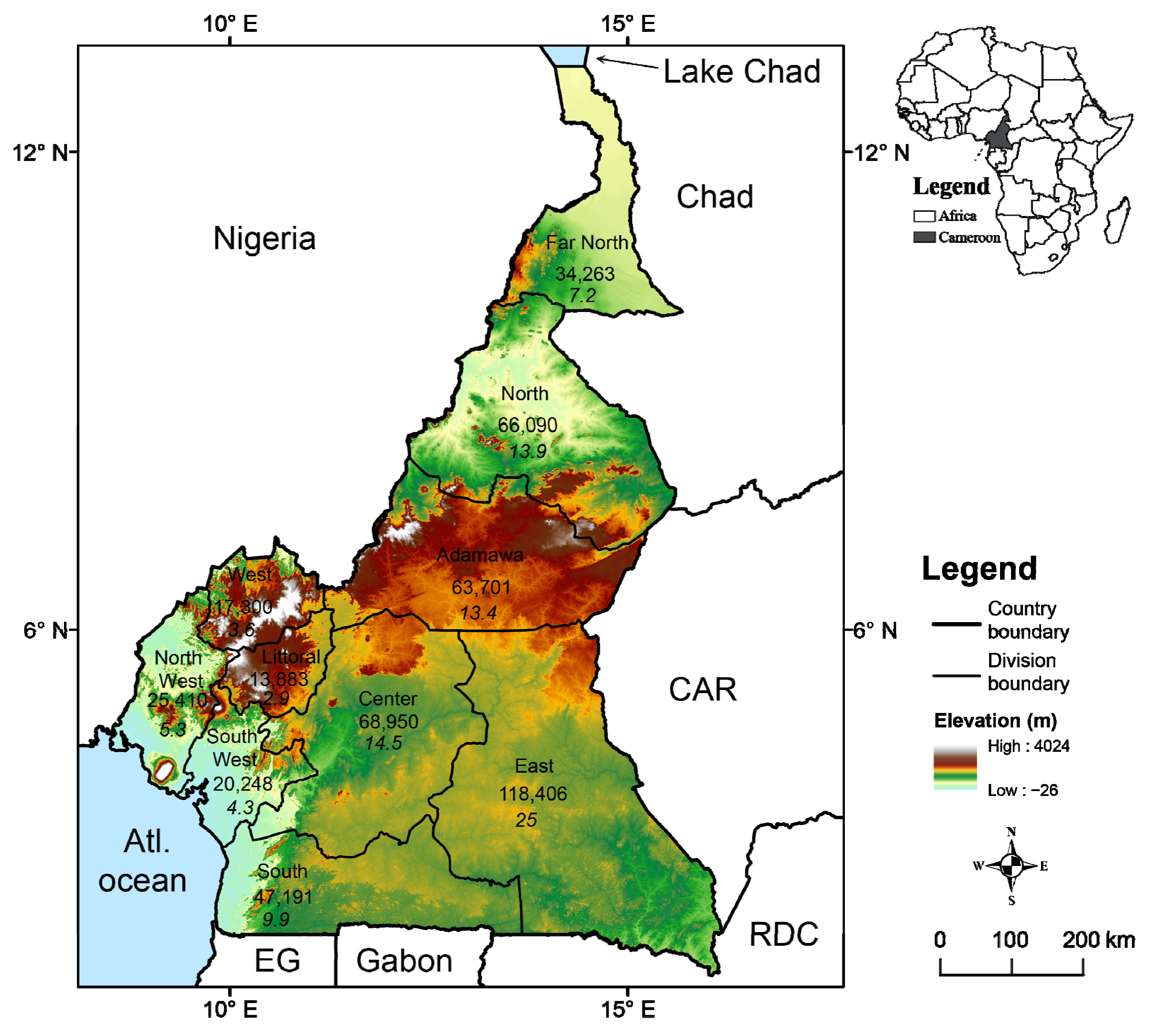
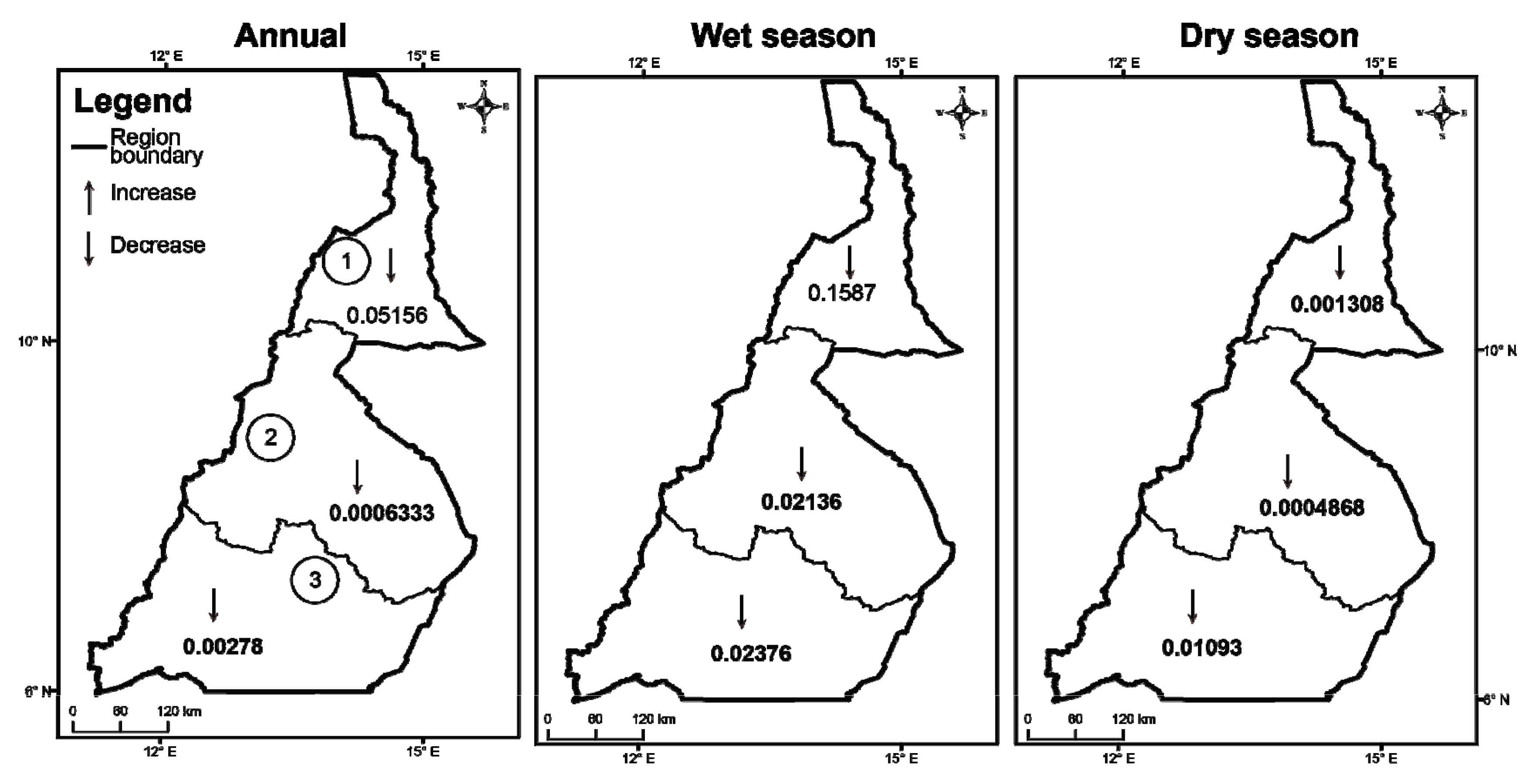
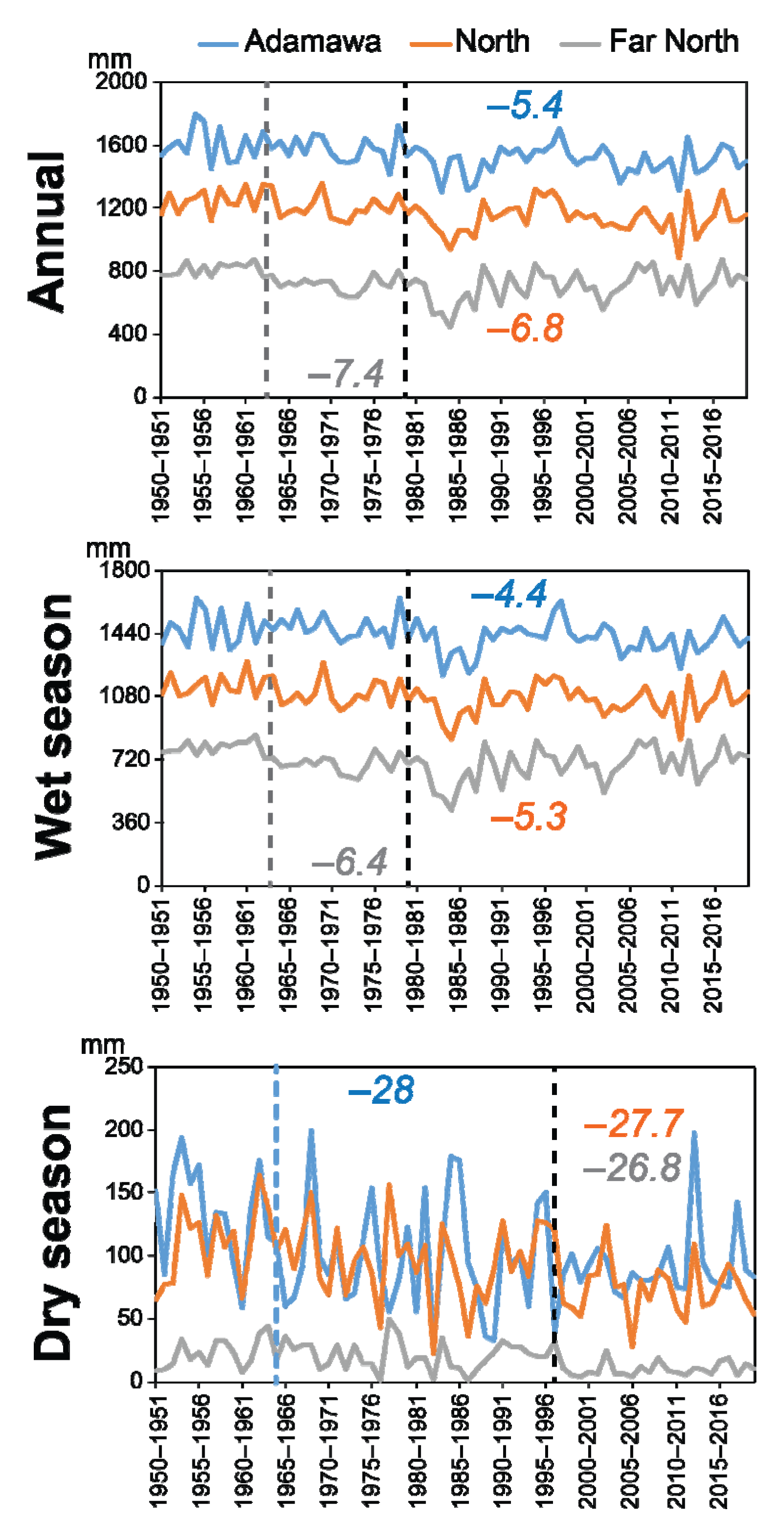
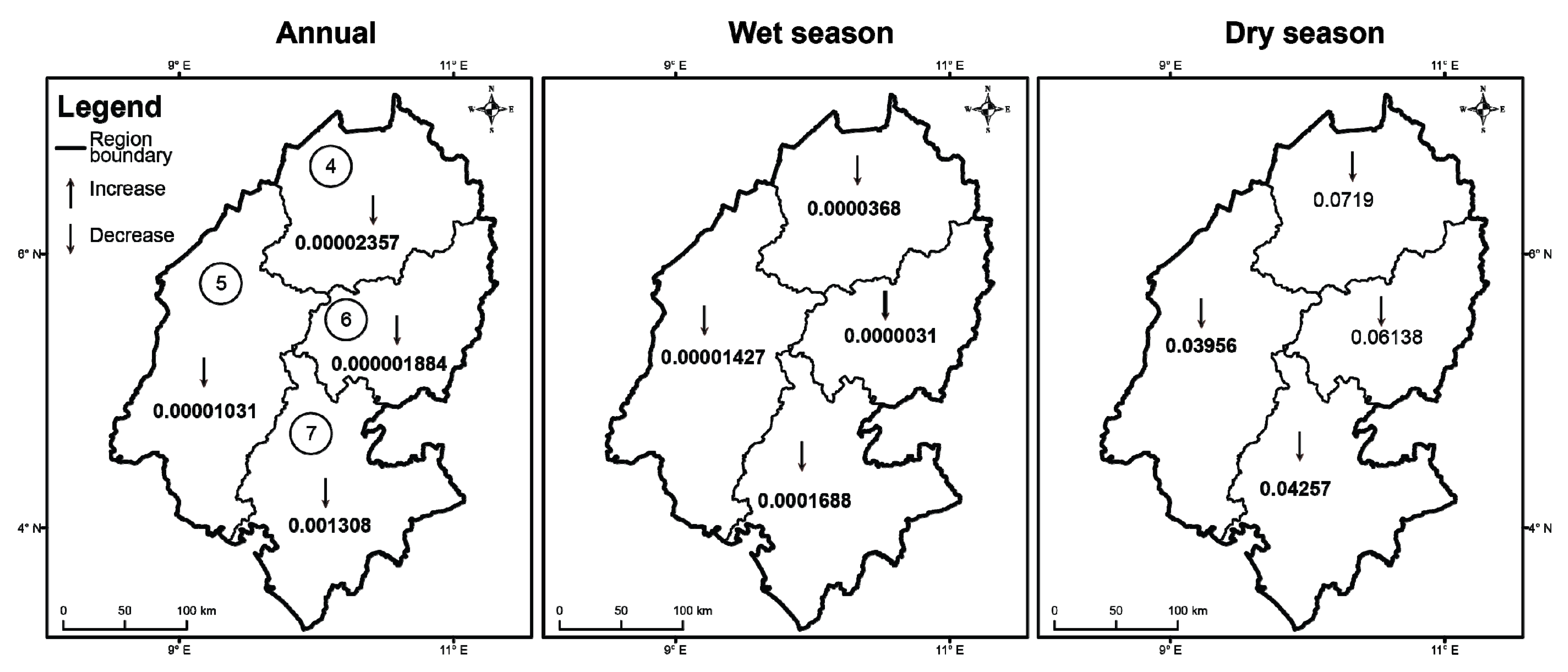
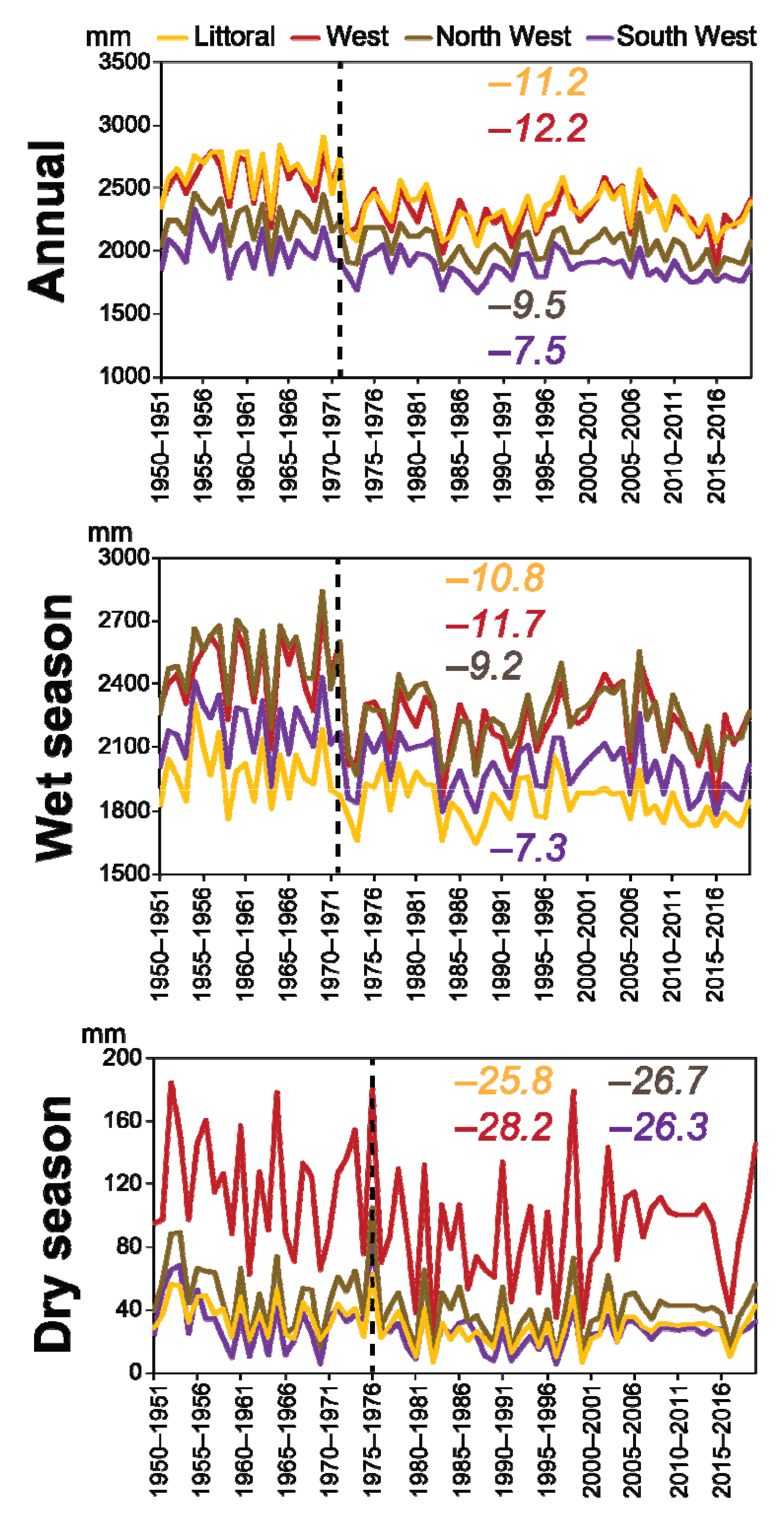
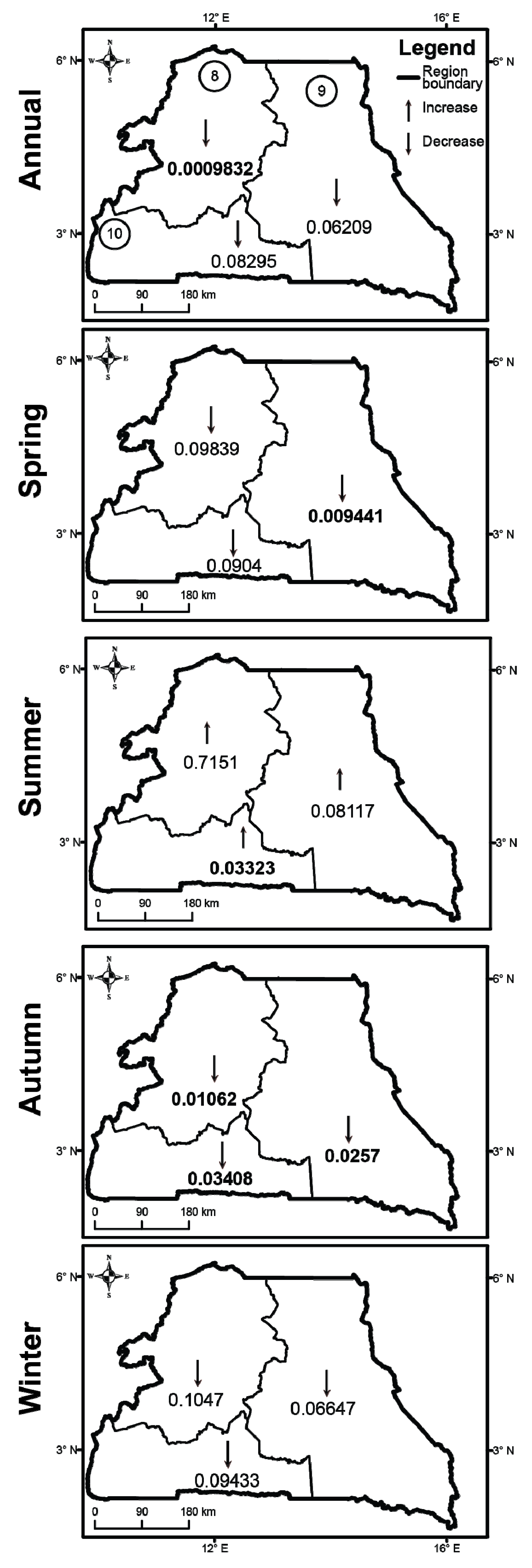

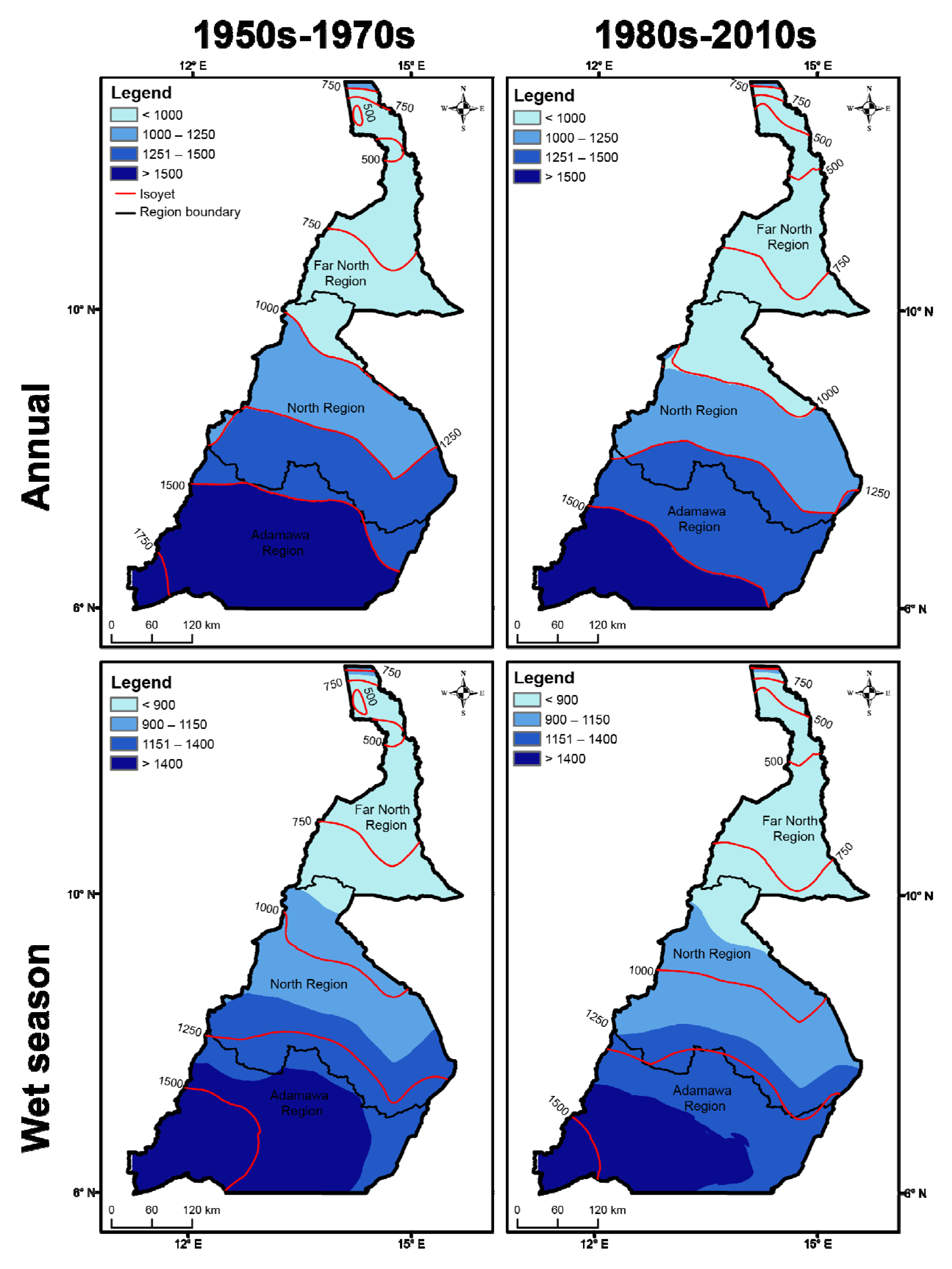
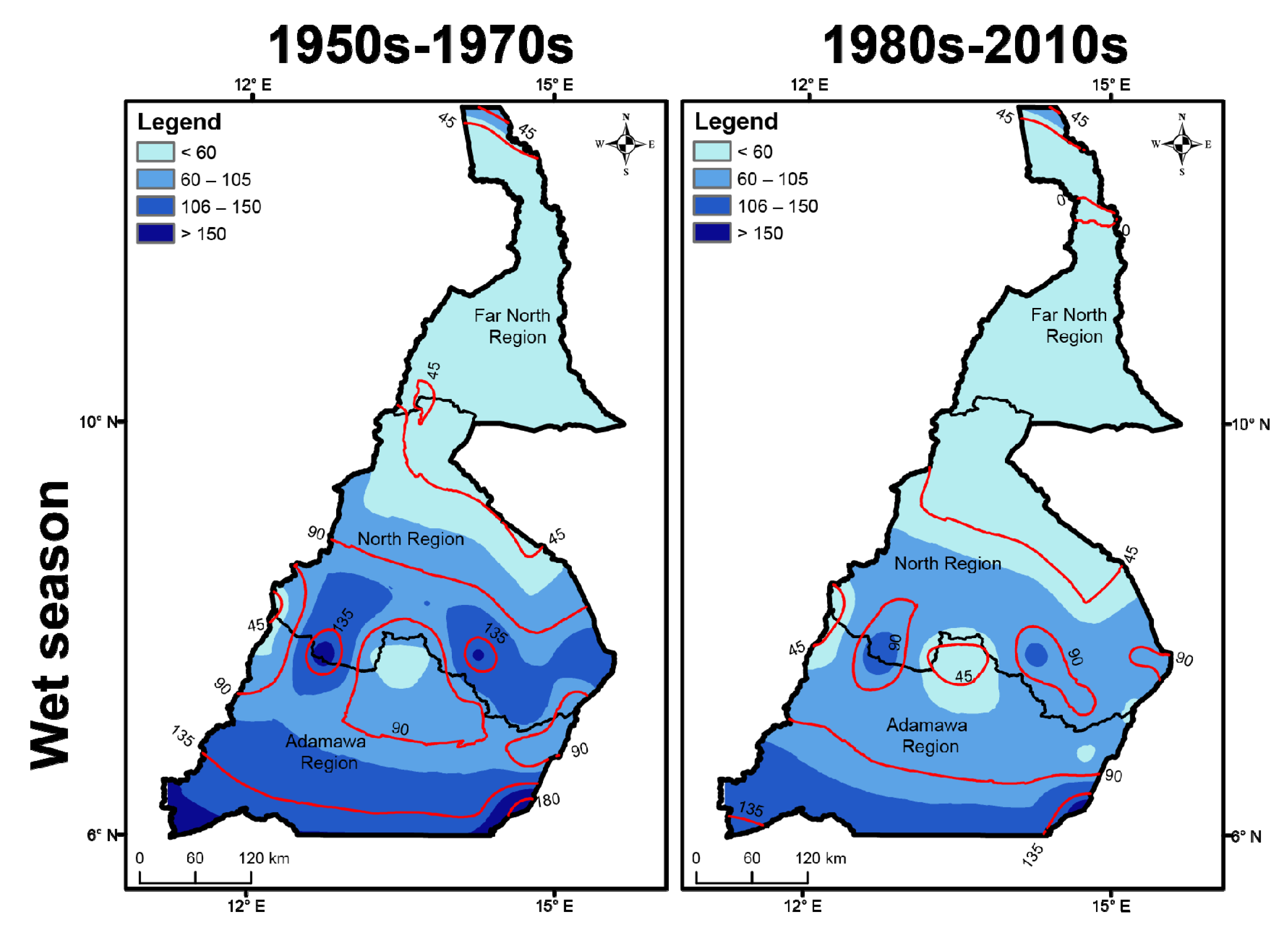
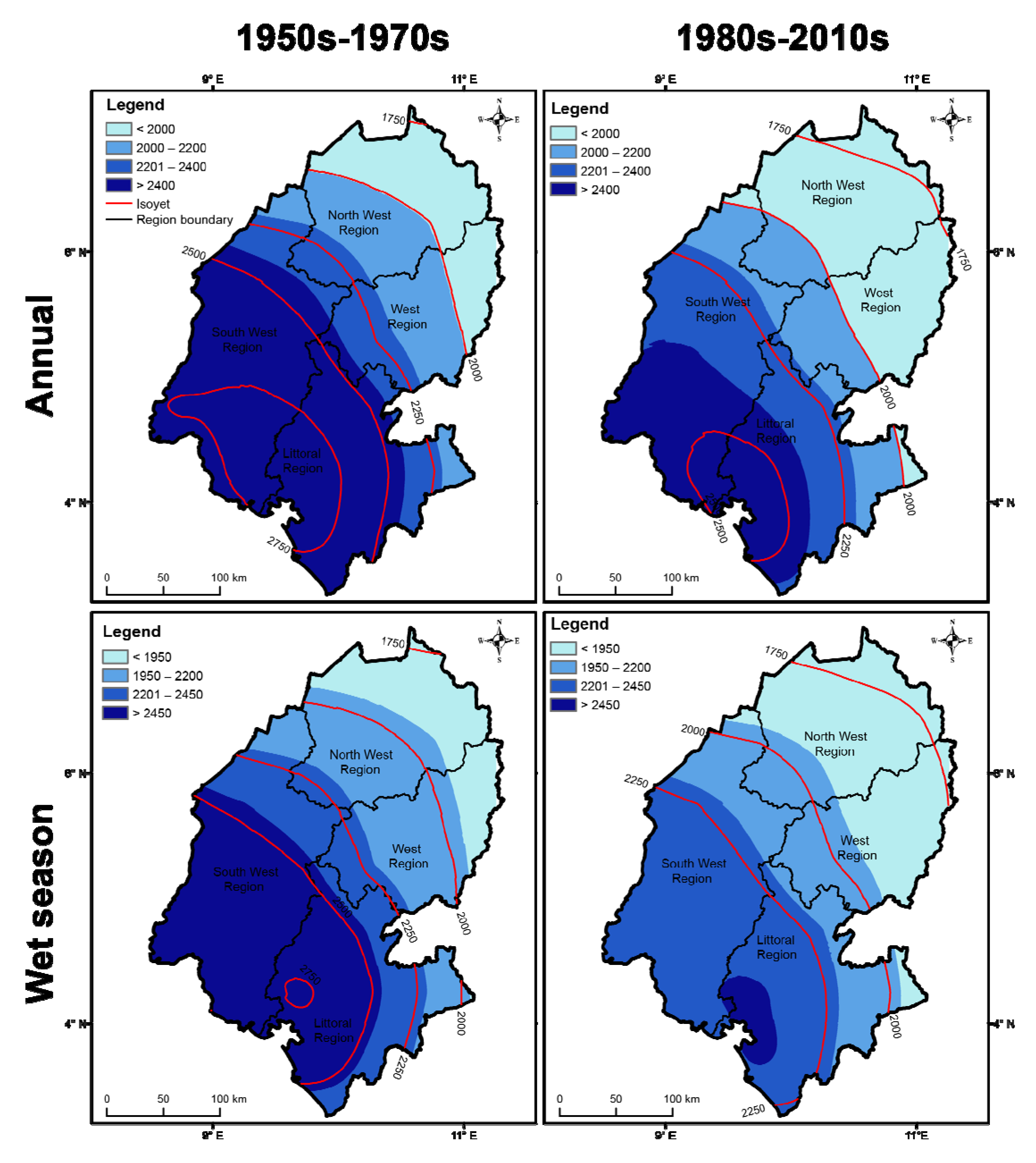

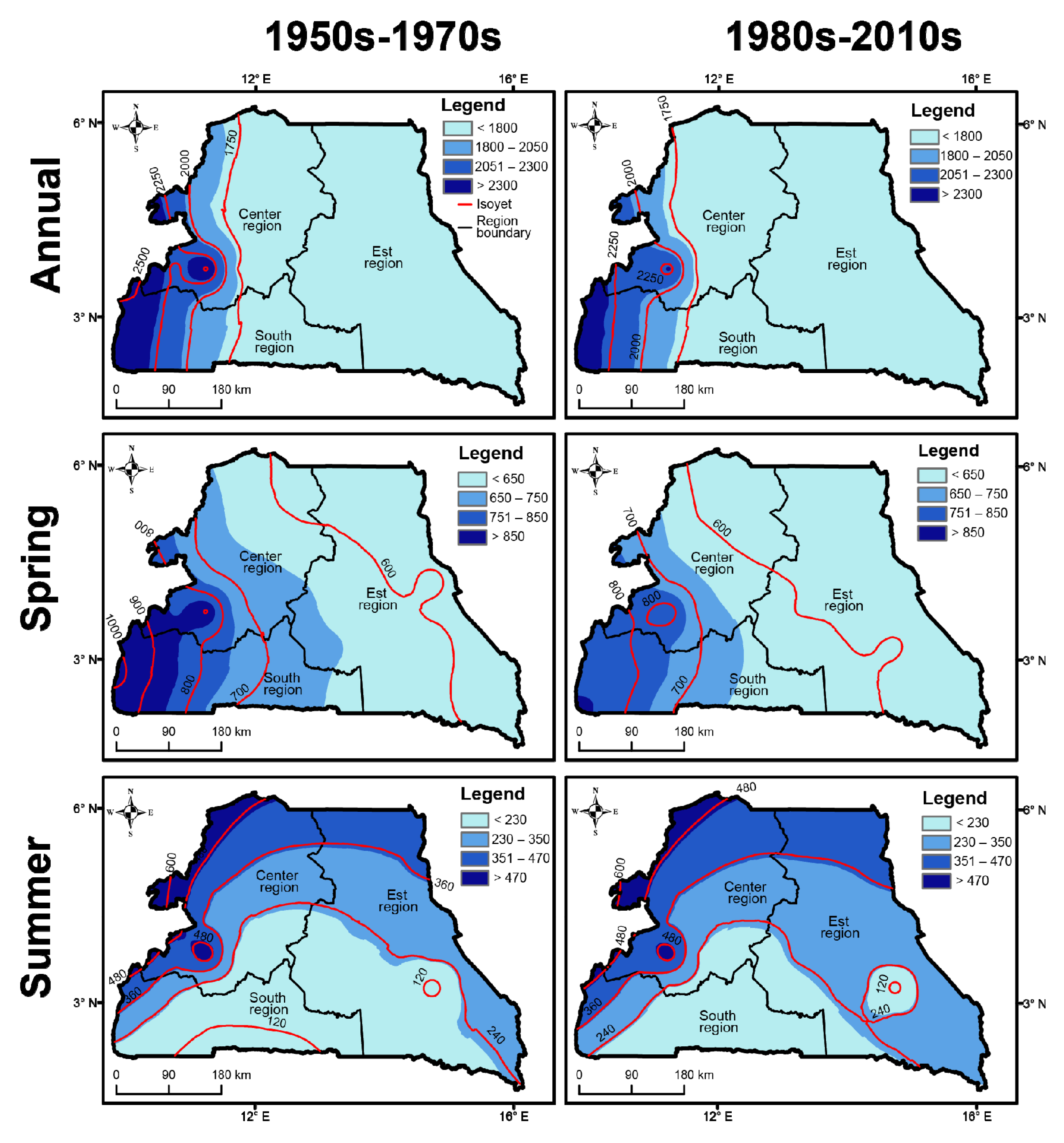

| Annual | Spring | Summer | Autumn | Winter | |||||||||||
|---|---|---|---|---|---|---|---|---|---|---|---|---|---|---|---|
| Center | East | South | Center | East | South | Center | East | South | Center | East | South | Center | East | South | |
| Mean rainfall (mm) | 1784 | 1580 | 1891 | 664 | 589 | 736 | 390 | 287 | 222 | 673 | 597 | 795 | 57 | 106 | 172 |
| Maximum rainfall (mm) | 2057 | 1869 | 2368 | 847 | 746 | 966 | 511 | 422 | 364 | 828 | 750 | 917 | 120 | 180 | 306 |
| Minimum rainfall (mm) | 1479 | 1348 | 1356 | 472 | 448 | 526 | 232 | 159 | 85 | 524 | 458 | 544 | 10.2 | 38.4 | 57.9 |
| CV | 0.07 | 0.065 | 0.09 | 0.10 | 0.09 | 0.12 | 0.14 | 0.2 | 0.27 | 0.09 | 0.09 | 0.10 | 0.41 | 0.31 | 0.3 |
| Adamawa | North | Far North | Littoral | North-West | West | South-West | |
|---|---|---|---|---|---|---|---|
| Annual | |||||||
| Mean rainfall (mm) | 1540 | 1174 | 726 | 2387 | 1911 | 2095 | 2413 |
| Maximum rainfall (mm) | 1799 | 1356 | 878 | 2834 | 2334 | 2457 | 2907 |
| Minimum rainfall (mm) | 1305 | 881 | 444 | 1849 | 1670 | 1824 | 2044 |
| CV | 0.07 | 0.08 | 0.13 | 0.09 | 0.07 | 0.08 | 0.09 |
| Wet season | |||||||
| Mean rainfall (mm) | 1437 | 1083 | 709 | 2288 | 1883 | 2052 | 2321 |
| Maximum rainfall (mm) | 1647 | 1283 | 861 | 2720 | 2309 | 2434 | 2845 |
| Minimum rainfall (mm) | 1196 | 834.2 | 431 | 1785 | 1646 | 1786 | 1962 |
| CV | 0.07 | 0.08 | 0.13 | 0.09 | 0.07 | 0.08 | 0.09 |
| Dry season | |||||||
| Mean rainfall (mm) | 103 | 91 | 17.7 | 100 | 28 | 43 | 31 |
| Maximum rainfall (mm) | 200 | 164.4 | 49.8 | 184.3 | 86 | 105 | 63 |
| Minimum rainfall (mm) | 27 | 22.74 | 0.6 | 22.24 | 6 | 9.52 | 7 |
| CV | 0.4 | 0.34 | 0.64 | 0.38 | 0.52 | 0.45 | 0.39 |
| Decades | Adamawa | North | Far North | Littoral | North-West | West | South-West |
|---|---|---|---|---|---|---|---|
| Annual | |||||||
| 1950 | 3.9 | 5.3 | 11.5 | 8.3 | 6.5 | 7.6 | 9.1 |
| 1960 | 4.8 | 6.5 | 4.5 | 8.2 | 5.2 | 6.7 | 9.4 |
| 1970 | 0.7 | 0.6 | −2.5 | −0.4 | 0.1 | 0.6 | −1.3 |
| 1980 | −5.3 | −6.8 | −12.4 | −5.9 | −4.2 | −4.4 | −6.3 |
| 1990 | 1.8 | 3.3 | −0.3 | −4.5 | −0.7 | −3 | −3.5 |
| 2000 | −4.7 | −4.8 | −1.1 | 1.1 | −1.5 | −0.9 | −0.7 |
| 2010 | −2.5 | −3.7 | 1.2 | −6.5 | −5.4 | −6.6 | −6.8 |
| Wet season | |||||||
| 1950 | 1.7 | 4.4 | 11.2 | 7.5 | 6 | 7.1 | 8.2 |
| 1960 | 4.6 | 4.8 | 3.3 | 8.1 | 5.5 | 6.9 | 9.5 |
| 1970 | 1.3 | 0.2 | −3.1 | −1 | −0.3 | 0.2 | −2 |
| 1980 | −5 | −6.2 | −12.4 | −5 | −3.9 | −4.1 | −5.4 |
| 1990 | 2.4 | 3.2 | −0.8 | −4.1 | −0.3 | −2.6 | −2.8 |
| 2000 | −2.7 | −4.1 | −0.2 | 1.2 | −1.5 | −0.9 | −0.6 |
| 2010 | −2.4 | −2.1 | 2.1 | −6.5 | −5.4 | −6.6 | −6.9 |
| Dry season | |||||||
| 1950 | 34.8 | 16.6 | 19 | 26.4 | 39.1 | 35.4 | 32.1 |
| 1960 | 8.4 | 25.8 | 45 | 10 | −16.5 | −4.2 | 7.4 |
| 1970 | −8.2 | 5.3 | 20.2 | 13.1 | 30.9 | 20 | 14.8 |
| 1980 | −8.8 | −13.7 | −16.5 | −26 | −22.1 | −18 | −27.2 |
| 1990 | −6 | 4.4 | 16 | −14.4 | −31.5 | −23 | −19.9 |
| 2000 | −15.1 | −13.1 | −42.8 | −0.1 | −1.5 | −2.1 | −1 |
| 2010 | −4 | −22.3 | −40.3 | −5.9 | −5 | −6.9 | −5.7 |
| Decades | Annual | Spring | Summer | Autumn | Winter | ||||||||||
|---|---|---|---|---|---|---|---|---|---|---|---|---|---|---|---|
| Center | East | South | Center | East | South | Center | East | South | Center | East | South | Center | East | South | |
| 1950 | 3.9 | 2.8 | 4 | 7.6 | 6.4 | 7 | −9.1 | −14 | −21 | 6.5 | 5.4 | 6.4 | 19.2 | 15.3 | 13.3 |
| 1960 | 4.3 | 3.4 | 3.8 | 3.6 | 3.8 | 4.8 | 3.7 | 0.4 | −3.8 | 4.3 | 2.9 | 1.9 | 16.3 | 13.4 | 17.4 |
| 1970 | 0.9 | −1.3 | −1.6 | −0.9 | −1.8 | −1.3 | 4.4 | −3.7 | −4.8 | −0.4 | −0.8 | −2.2 | 12.9 | 5.6 | 3.4 |
| 1980 | −3.5 | −2.3 | −3.6 | −5.7 | −1.7 | −4.9 | 5.6 | 5.8 | 9.3 | −4.6 | −3.9 | −2.4 | −26 | −18 | −20 |
| 1990 | −2.2 | −0.7 | −2.6 | −4 | −3.2 | −5.3 | 4.6 | 11 | 13.6 | −3 | −1.5 | −2.7 | −19 | −13 | −12 |
| 2000 | 0.2 | −1.8 | 3.2 | −0.4 | −4 | 1.3 | 0.2 | 2 | 5.8 | 0.8 | −2.2 | 4.5 | 1.2 | 3.2 | 2.5 |
| 2010 | −3.6 | −0.3 | −3.3 | −0.4 | 1 | −1.2 | −8.7 | −1 | −0.4 | −3.6 | 0 | −5.7 | −6.6 | −6.9 | −5.5 |
Publisher’s Note: MDPI stays neutral with regard to jurisdictional claims in published maps and institutional affiliations. |
© 2022 by the author. Licensee MDPI, Basel, Switzerland. This article is an open access article distributed under the terms and conditions of the Creative Commons Attribution (CC BY) license (https://creativecommons.org/licenses/by/4.0/).
Share and Cite
Ebodé, V.B. Analysis of the Spatio-Temporal Rainfall Variability in Cameroon over the Period 1950 to 2019. Atmosphere 2022, 13, 1769. https://doi.org/10.3390/atmos13111769
Ebodé VB. Analysis of the Spatio-Temporal Rainfall Variability in Cameroon over the Period 1950 to 2019. Atmosphere. 2022; 13(11):1769. https://doi.org/10.3390/atmos13111769
Chicago/Turabian StyleEbodé, Valentin Brice. 2022. "Analysis of the Spatio-Temporal Rainfall Variability in Cameroon over the Period 1950 to 2019" Atmosphere 13, no. 11: 1769. https://doi.org/10.3390/atmos13111769
APA StyleEbodé, V. B. (2022). Analysis of the Spatio-Temporal Rainfall Variability in Cameroon over the Period 1950 to 2019. Atmosphere, 13(11), 1769. https://doi.org/10.3390/atmos13111769







